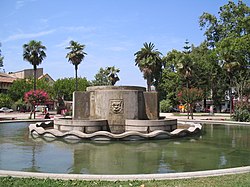Quillota, Chile
| Quillota | |||||
|---|---|---|---|---|---|
| City and Commune | |||||
 |
|||||
|
|||||
| Motto: City created with care (Ciudad creada con cariño) |
|||||
| Coordinates: 32°52′S 71°15′W / 32.867°S 71.250°WCoordinates: 32°52′S 71°15′W / 32.867°S 71.250°W | |||||
| Country | Chile | ||||
| Region | Valparaíso | ||||
| Province | Quillota | ||||
| Founded | November 11, 1717 | ||||
| Government | |||||
| • Type | Municipality | ||||
| • Alcalde | Luis Alberto Mella Gajardo (DC) | ||||
| Area | |||||
| • Total | 302 km2 (117 sq mi) | ||||
| Elevation | 462 m (1,516 ft) | ||||
| Population (2012 Census) | |||||
| • Total | 85,262 | ||||
| • Density | 280/km2 (730/sq mi) | ||||
| • Urban | 66,025 | ||||
| • Rural | 9,891 | ||||
| Demonym(s) | Quillotan | ||||
| Sex | |||||
| • Men | 37,191 | ||||
| • Women | 38,725 | ||||
| Time zone | CLT (UTC-4) | ||||
| • Summer (DST) | CLST (UTC-3) | ||||
| Postal code | 2430000 | ||||
| Area code(s) | 56 + 33 | ||||
| Climate | Csb | ||||
| Website | Official website (in Spanish) | ||||
Quillota is a city located in the Aconcagua River valley of central Chile's Valparaíso Region. It is the capital and largest city of the Quillota Province where many inhabitants live in the surrounding farm areas of San Isidro, La Palma, Pocochay, and San Pedro. It is an important agricultural center, mainly because the plantations of avocado and cherimoya (custard apple) trees.
Quillota is connected with the city of La Calera by the small town of La Cruz. The area's agriculture and landscape was described by Charles Darwin in his book The Voyage of the Beagle. Nearby La Campana National Park holds a plaque at a viewpoint Darwin once visited.
Quillota is 120 kilometres (75 mi) from the national capital Santiago and 60 km (37 mi) from the regional capital Valparaíso.
The Quillota valley has been densely populated for about 2,000 years. At the outset, the area was inhabited by Native Americans of the Bato and Lleo-Lleo cultures, who had migrated to the valley because of the fertile land south of the Aconcagua River. These natives where later influenced by Mapuches and Diaguitas. The Diaguitas are credited with the evolution of the local culture of the Aconcagua zone and were well known for their pottery.
...
Wikipedia



